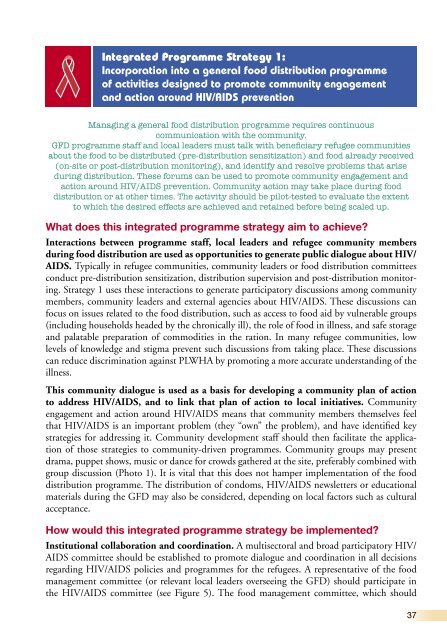Integration of HIV/AIDS activities with food and nutrition support in ...
Integration of HIV/AIDS activities with food and nutrition support in ...
Integration of HIV/AIDS activities with food and nutrition support in ...
Create successful ePaper yourself
Turn your PDF publications into a flip-book with our unique Google optimized e-Paper software.
Integrated Programme Strategy 1:<br />
Incorporation <strong>in</strong>to a general <strong>food</strong> distribution programme<br />
<strong>of</strong> <strong>activities</strong> designed to promote community engagement<br />
<strong>and</strong> action around <strong>HIV</strong>/<strong>AIDS</strong> prevention<br />
Manag<strong>in</strong>g a general <strong>food</strong> distribution programme requires cont<strong>in</strong>uous<br />
communication <strong>with</strong> the community.<br />
GFD programme staff <strong>and</strong> local leaders must talk <strong>with</strong> beneficiary refugee communities<br />
about the <strong>food</strong> to be distributed (pre-distribution sensitization) <strong>and</strong> <strong>food</strong> already received<br />
(on-site or post-distribution monitor<strong>in</strong>g), <strong>and</strong> identify <strong>and</strong> resolve problems that arise<br />
dur<strong>in</strong>g distribution. These forums can be used to promote community engagement <strong>and</strong><br />
action around <strong>HIV</strong>/<strong>AIDS</strong> prevention. Community action may take place dur<strong>in</strong>g <strong>food</strong><br />
distribution or at other times. The activity should be pilot-tested to evaluate the extent<br />
to which the desired effects are achieved <strong>and</strong> reta<strong>in</strong>ed before be<strong>in</strong>g scaled up.<br />
What does this <strong>in</strong>tegrated programme strategy aim to achieve?<br />
Interactions between programme staff, local leaders <strong>and</strong> refugee community members<br />
dur<strong>in</strong>g <strong>food</strong> distribution are used as opportunities to generate public dialogue about <strong>HIV</strong>/<br />
<strong>AIDS</strong>. Typically <strong>in</strong> refugee communities, community leaders or <strong>food</strong> distribution committees<br />
conduct pre-distribution sensitization, distribution supervision <strong>and</strong> post-distribution monitor<strong>in</strong>g.<br />
Strategy 1 uses these <strong>in</strong>teractions to generate participatory discussions among community<br />
members, community leaders <strong>and</strong> external agencies about <strong>HIV</strong>/<strong>AIDS</strong>. These discussions can<br />
focus on issues related to the <strong>food</strong> distribution, such as access to <strong>food</strong> aid by vulnerable groups<br />
(<strong>in</strong>clud<strong>in</strong>g households headed by the chronically ill), the role <strong>of</strong> <strong>food</strong> <strong>in</strong> illness, <strong>and</strong> safe storage<br />
<strong>and</strong> palatable preparation <strong>of</strong> commodities <strong>in</strong> the ration. In many refugee communities, low<br />
levels <strong>of</strong> knowledge <strong>and</strong> stigma prevent such discussions from tak<strong>in</strong>g place. These discussions<br />
can reduce discrim<strong>in</strong>ation aga<strong>in</strong>st PLWHA by promot<strong>in</strong>g a more accurate underst<strong>and</strong><strong>in</strong>g <strong>of</strong> the<br />
illness.<br />
This community dialogue is used as a basis for develop<strong>in</strong>g a community plan <strong>of</strong> action<br />
to address <strong>HIV</strong>/<strong>AIDS</strong>, <strong>and</strong> to l<strong>in</strong>k that plan <strong>of</strong> action to local <strong>in</strong>itiatives. Community<br />
engagement <strong>and</strong> action around <strong>HIV</strong>/<strong>AIDS</strong> means that community members themselves feel<br />
that <strong>HIV</strong>/<strong>AIDS</strong> is an important problem (they “own” the problem), <strong>and</strong> have identified key<br />
strategies for address<strong>in</strong>g it. Community development staff should then facilitate the application<br />
<strong>of</strong> those strategies to community-driven programmes. Community groups may present<br />
drama, puppet shows, music or dance for crowds gathered at the site, preferably comb<strong>in</strong>ed <strong>with</strong><br />
group discussion (Photo 1). It is vital that this does not hamper implementation <strong>of</strong> the <strong>food</strong><br />
distribution programme. The distribution <strong>of</strong> condoms, <strong>HIV</strong>/<strong>AIDS</strong> newsletters or educational<br />
materials dur<strong>in</strong>g the GFD may also be considered, depend<strong>in</strong>g on local factors such as cultural<br />
acceptance.<br />
How would this <strong>in</strong>tegrated programme strategy be implemented?<br />
Institutional collaboration <strong>and</strong> coord<strong>in</strong>ation. A multisectoral <strong>and</strong> broad participatory <strong>HIV</strong>/<br />
<strong>AIDS</strong> committee should be established to promote dialogue <strong>and</strong> coord<strong>in</strong>ation <strong>in</strong> all decisions<br />
regard<strong>in</strong>g <strong>HIV</strong>/<strong>AIDS</strong> policies <strong>and</strong> programmes for the refugees. A representative <strong>of</strong> the <strong>food</strong><br />
management committee (or relevant local leaders oversee<strong>in</strong>g the GFD) should participate <strong>in</strong><br />
the <strong>HIV</strong>/<strong>AIDS</strong> committee (see Figure 5). The <strong>food</strong> management committee, which should<br />
37

















